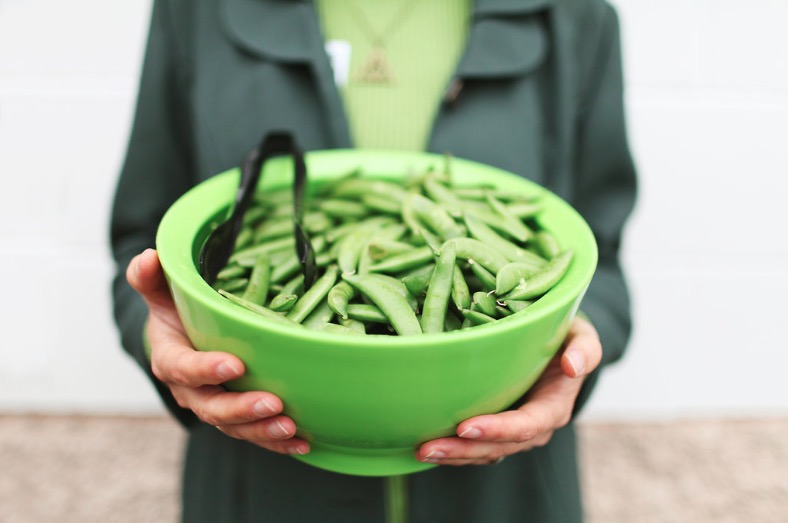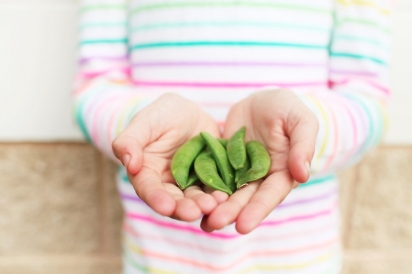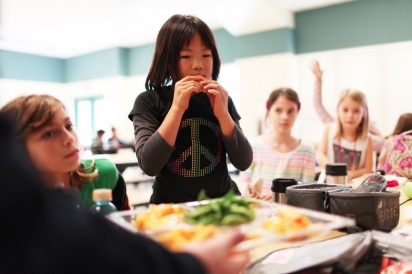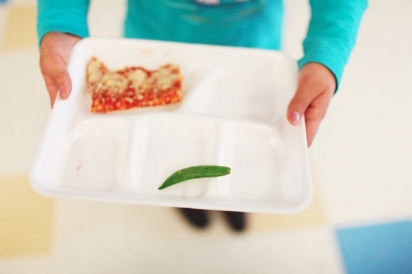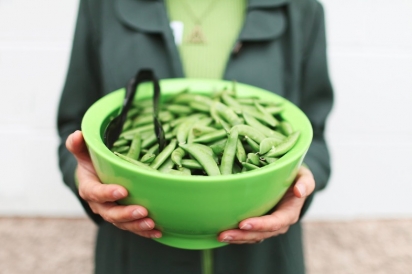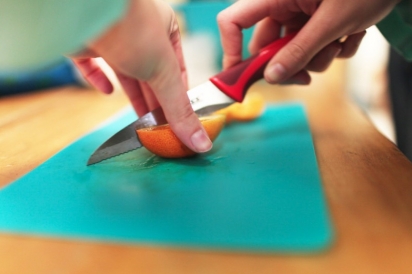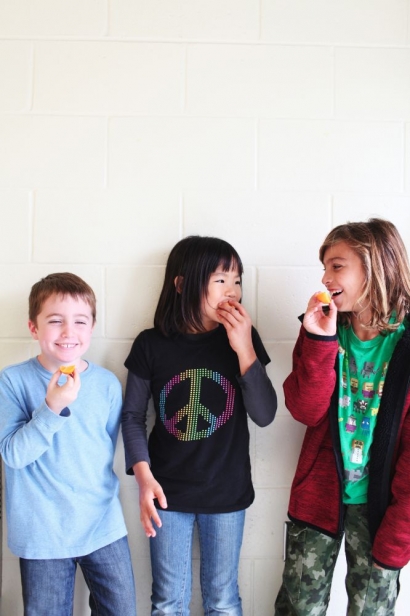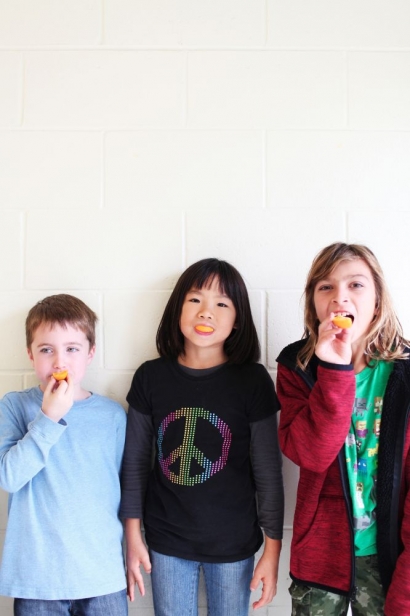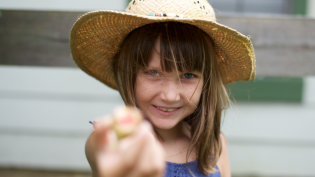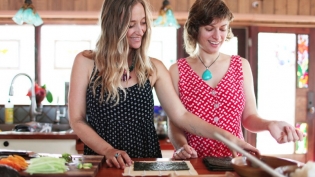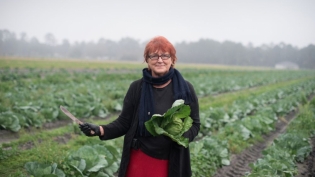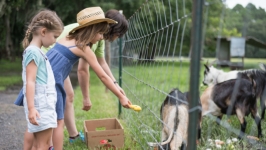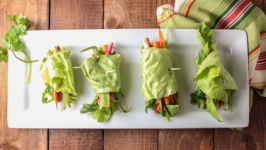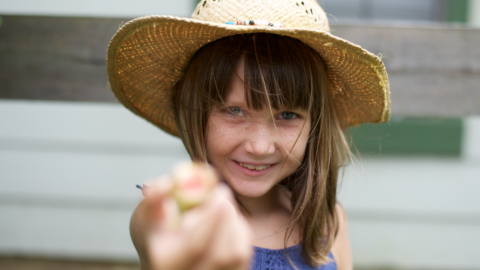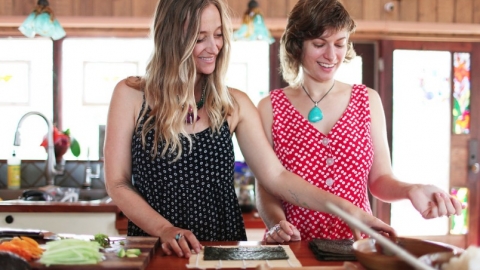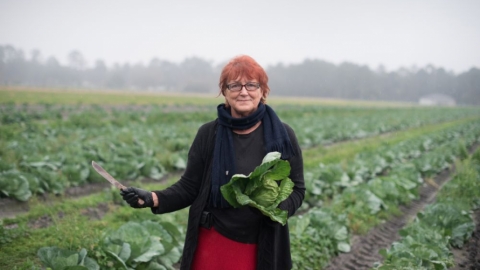Experimenting with Food
When your mom packs you Brussels sprouts for lunch in second grade, the school cafeteria becomes a rough place. Not because you don’t like Brussels sprouts; you do. But no one else does. And they say things. “Don’t yuck my yum!” you were taught to say. But it doesn’t work with Brussels sprouts.
My son asked me to stop packing vegetables and replace them with fruit cocktail. I complied as much as I could. Then I met a dietician who had a similar experience with her daughter. We approached the school principal with a crazy idea: If we could show kids that vegetables were cool, maybe our kids would be able to eat their Brussels sprouts in peace.
This year marks my 10th year of being the school’s “Munchy Monday Mom.” I walk into the school with my trademark green bowls and kids stop me in the hall, wanting to know what I’ve brought. By the time I hit the lunchroom, there is already a buzz. At the first table, bowl tipped towards my chest so the kids can’t see what is inside, I watch the hands go up, kids already begging.
“What do you think I brought today?”
“I dunno.”
I laugh. “Fish eyeballs. Very healthy. Want one?”
The kids laugh back, uncertain, but the hands don’t drop. I relent.
“It is sorrel.” Hands stay up, but now they are concerned.
“Sorrel?”
“Yeah, a green weed with a lemony flavor.”
This is the fourth–fifth grade, and I can joke around. And then they empty my bowl. These kids will eat anything. AN-Y-THING! Papaya. Golden beets. Fennel. Jicama. Zucchini!
Munchy Monday (or Tasty Tuesday/Thursday, Wonderful Wednesday, Fresh Friday) is my favorite way to volunteer at the school. It takes four hours a week for as many weeks as I feel like doing it. Even prepping is fun. (Once I seeded and peeled 50 mangoes, and I now KNOW the best way.)
The program is pretty simple: I buy a fruit or vegetable in enough quantity to provide a small sample for each kid (a ¼-inch round of kiwi). I prep the samples, and then I hang out in the lunchroom for the whole threehour lunch cycle, offering samples to each table, along with an information slip. That’s it. My PTA covers the cost with enthusiasm, whether I shop seasonally and spend $200 or I splurge with more exotic choices and go up to $500. Each child has the opportunity to try 10 samples of different fruits and vegetables for less than a dollar a child.
As a folklorist and college teacher, I can say a few things about why the crazy idea worked. The first key is that I work within the existing cultures (here goes the academic). One culture is the existing lunchroom system. When we tried having samples at a table near the lunch line, the chaos created when the kids ran over was an obvious mistake, even to lunchroom rookies. Now we come to each table and they stay seated. We are careful about the potential for mess or trash. I tried something on toothpicks once, and realized that I’d just armed 500 kids with tiny swords.
Working within kids’ culture is equally important. The original impetus for the format was noticing that my kids would even eat fish if it was offered as a free sample at Publix. I also realized that the influence kids have over each other’s eating habits can be positive just as easily as negative. So I hang around a few minutes, responding enthusiastically to the kids who like it. Invariably, another kid will be won over without my ever having said a word, wanting a sample as I leave.
I break the adult rules but not the kid rules. I never, never, never push kids to try anything. My goal is to empower kids to want to expand their own horizons and make healthy choices for themselves. I break the rules of good manners in the name of empowerment: “This is an experiment. You can use all your senses—why don’t you just smell it? Or lick it, and if it seems OK, then take a bite so small I can’t see it. Not so bad? Eat the whole thing, or chuck it in the garbage. I don’t really care.” Legal “naughtiness” encourages some to give it a whirl who otherwise might not.
I have researched the evolution of manners and I know that we have dinnertime rules for a reason, and why we aren’t supposed to play with food. But there are mannerly ways to experiment, too. Once, kids weren’t eating my beautiful trays of red and yellow peppers. I offered a challenge: Try both and vote for the best!
That extended to different salad greens (red romaine, butter head and arugula). I hadn’t realized how much subtle variety there is. And pears! Try an Anjou, a Bartlett, a Bosc and a Comice in one sitting. You’ll see—it is an eye-opener. Taste tests prompt us to eat seasonally, too, when the food will taste the best and be the cheapest because that is when we get enough variety of one type to run a good experiment.
I don’t know why we parents got into the habit of requiring kids to put bitter-tasting foods into their bodies against their will in the first place. There is nothing more intimate than taking something into your body. Should anyone, even a parent, have the right to insist on that? Most things that are toxic are bitter, so evolutionarily, it is sensible to avoid kale at first. I want to eliminate the power struggle around healthy eating. We should challenge kids to eat healthy veggies, but “challenge” doesn’t mean “force.”
I do an activity with the kids called “food conquering.” Here are the rules: Each child chooses a food they don’t currently like and want to conquer. They then figure out their strategy. Some kids research why it is healthy. Other kids use sheer repetition: We supposedly need 10 tries before we can know if we like a food. Maybe eating it with a friend who likes it or at a party offers motivation. For many people, trying different varieties, recipes or preparations works. Others prefer to creep up on it through microscopic bites, or bury it in something, like soup or on pizza. The kids nearly always conquer their foods, at least enough to stop picking mushrooms off their pizza. Many choose to do it again and again on their own, because it makes them proud. That is one way to challenge kids while empowering them.
What I have learned from this journey my son set me on is that there is pleasure in food, even vegetables. And there is great joy in exploration. My new mantra: Out with the battle armor and the plate of peas that sits there forever and in with the lab coat and the smile.


